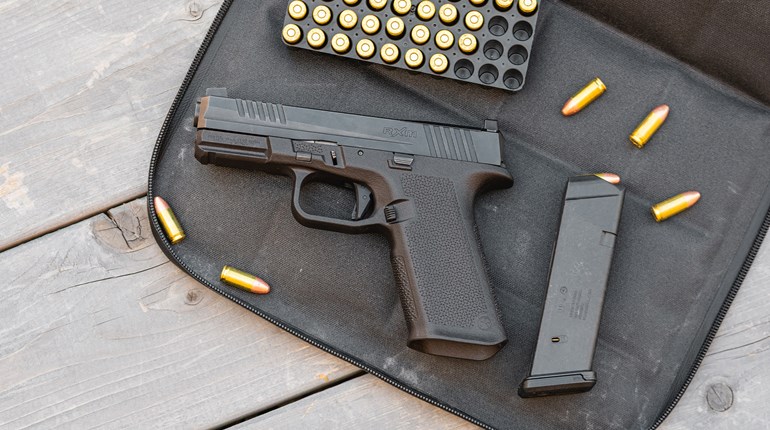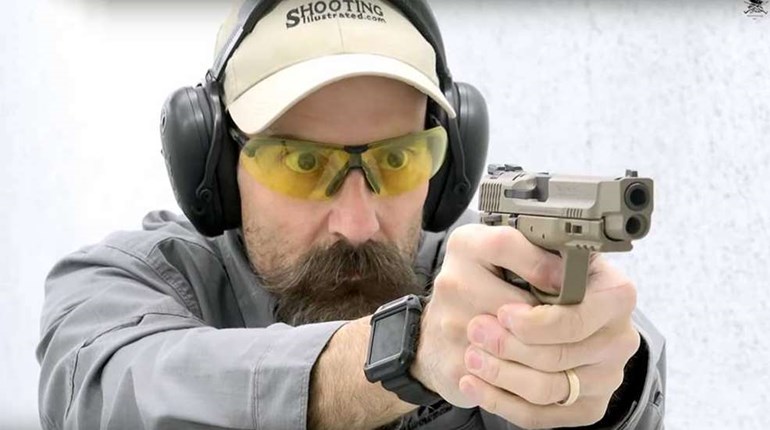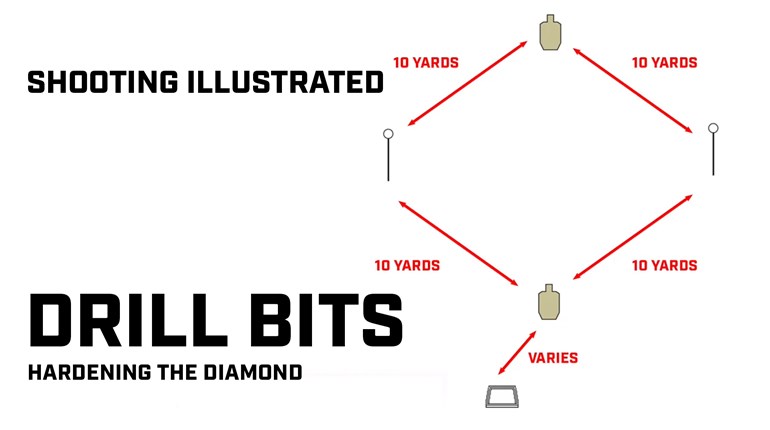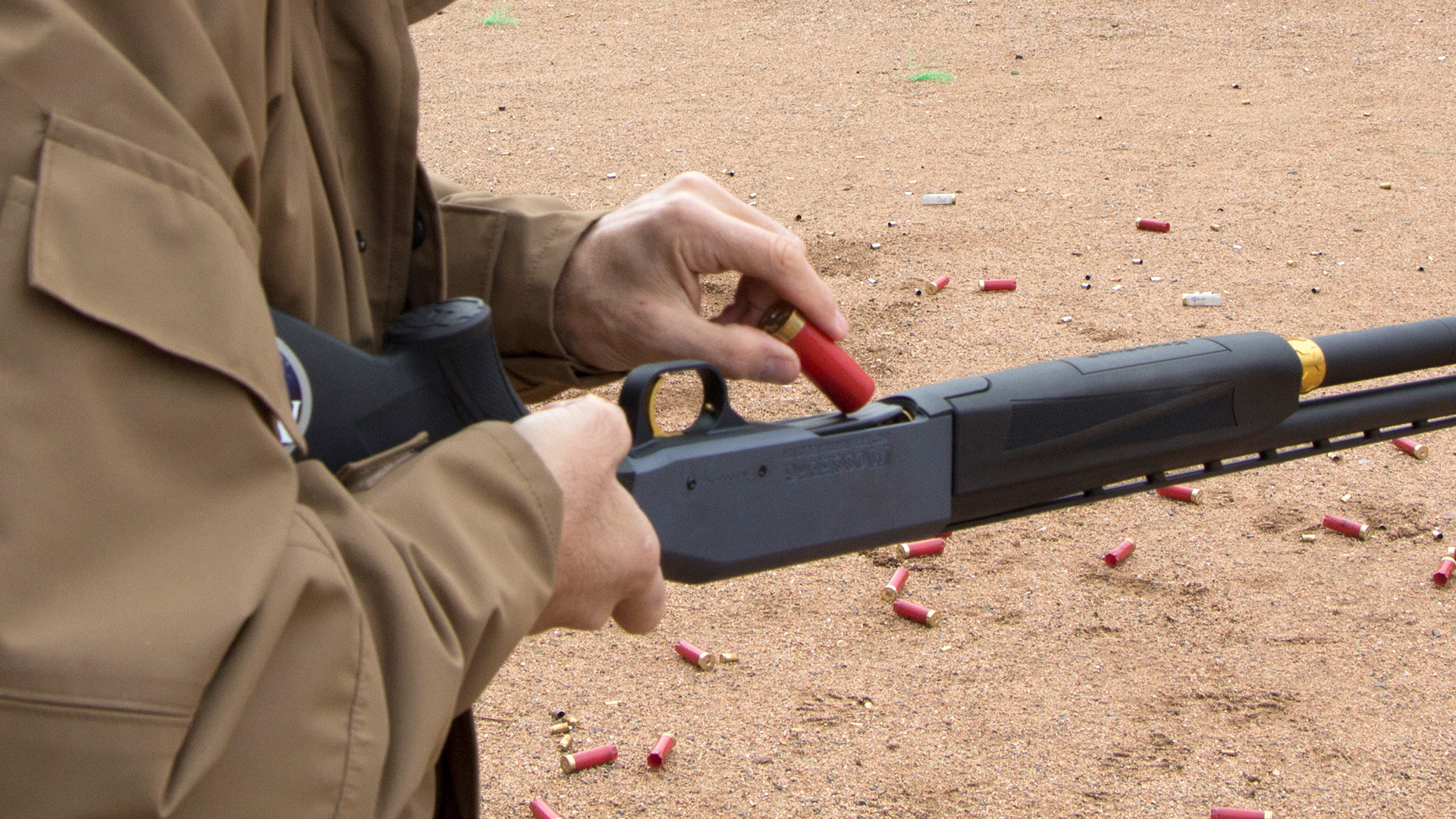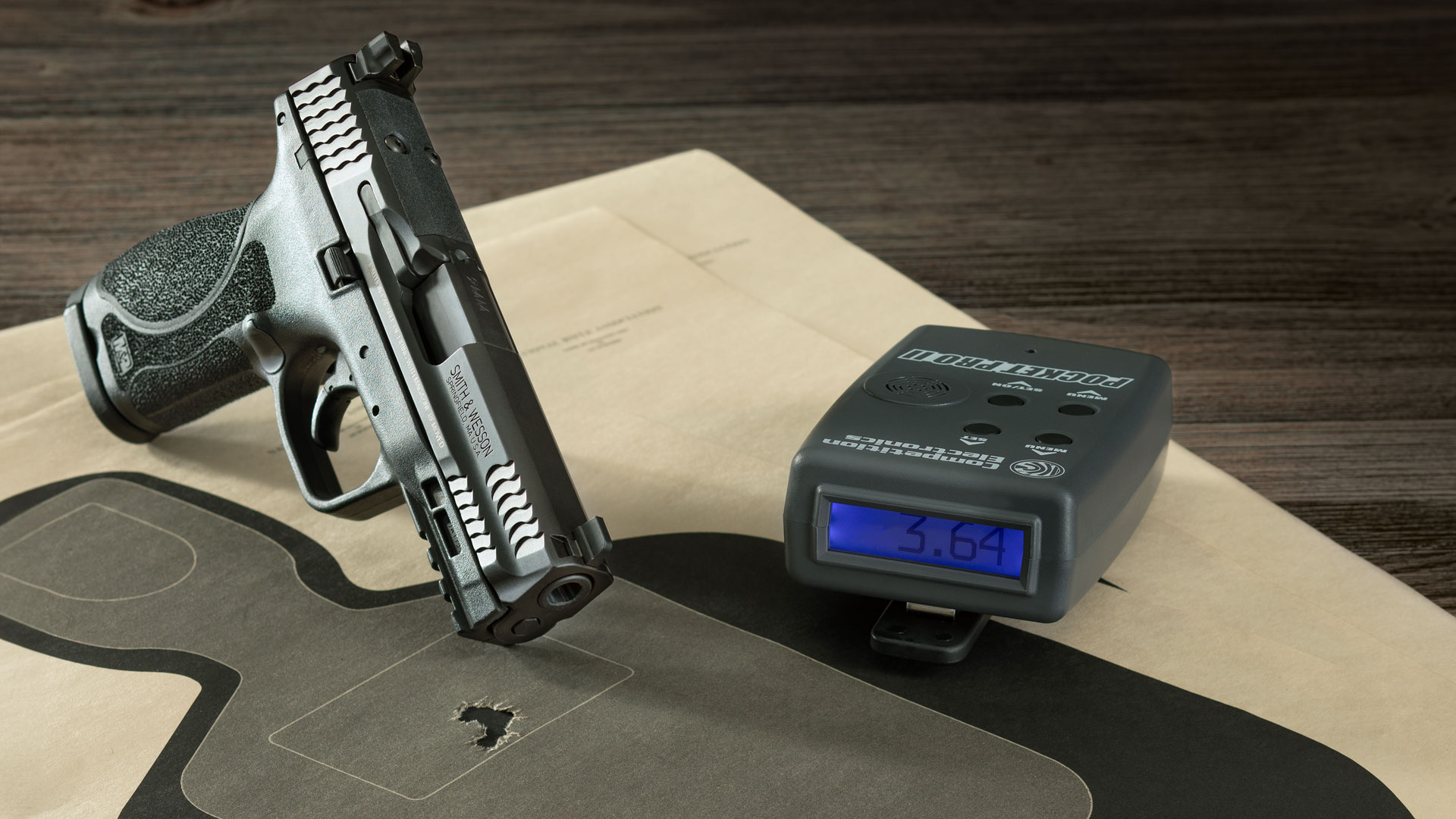
When it comes to sending fast and accurate rounds downrange, the bottom line is to hit what you’re aiming at in a timely manner. However, when placed under the demand of exceptional speed, specific fire-control elements come into play. Once they are identified and isolated, these subcomponents—when refined—can be integrated back into your fire-control matrix to significantly enhance your shooting performance.
A good shooter trains to expand their skills, resulting in greater on-demand performance. Holding oneself to higher standards for accuracy and speed requires a commensurate level of commitment and discipline. Although there are limitless aspects of shooting performance that can be addressed, the focus of this study is on the core functional elements of fire control.
Fire control can be defined as “the repeatable ability to efficiently deliver well-placed rounds in a timely manner.” Using this definition sets the stage for meeting objectives based on measurable standards.
Again, it is important to emphasize that not all triggers are the same and therefore will have a different number of engagement positions based on the press.
Ultimately, shooting well is the product of applying good habits, developing subconscious competence and achieving the holy grail of consistency. Polishing these coveted gems (competency and consistency) starts with taking the time to develop good habits, differentiating “right” from “wrong” and building personal confidence. Each are interrelated building blocks, each comprising the bedrock of good fire control. The aforementioned subcomponents to be identified, isolated and further refined are hold control, trigger control and visual control.
Hold control is an NRA term describing your ability to keep the muzzle from moving out of alignment with the target while breaking the shot. It can be further dissected into its three subcomponent parts: grip, hold and press.
First and foremost of the hold-control subcomponents is grip. This starts with the strong hand, which is further stabilized by utilizing the support hand in tandem with the strong hand, resulting in stability. The job responsibility of the support hand is to steer and keep the muzzle in alignment with the target. Yet, the primary role and responsibility of the strong hand is trigger manipulation.
Once you have established your signature grip, strong-hand supported, it is imperative to maintain a durable grip throughout the fire-control process. Grip durability means that the combined weld of your strong hand and support hand is one that remains fixed in both position and pressure. In other words, it means not changing either hand or finger position, while not fluctuating in grip pressure throughout the first and subsequent shot breaks. A change in either grip position or grip pressure can produce unwanted energy input resulting in muzzle movement enough to attenuate hold control (moving the muzzle out of target alignment.)
Developing good grip habits means eliminating any unnecessary input, which translates to grip durability. Mindful practice, cognizant of the objective of a durable grip is what helps you develop good grip habits. The more you can discern “right” (building and sustaining a durable grip) from “wrong” (detrimental energy input) the more familiar you become with the durability process.
The greater your grip familiarity, the greater your grip comfort, which, in turn, allows for your conscious work effort to drop into the subconscious. The deeper into the subconscious a good grip falls coupled with experiencing performance success, the greater your confidence.
Greater confidence leads to on-demand repeatability, which is just another term for consistency. In the world of performance shooting, 85 percent is considered a desirable consistency percentage.

The second element of the hold-control triumvirate is the stability of alignment. What is meant by this, provided you have built and sustained a durable grip, is to keep your sights within an acceptable margin of “arc-of-wobble.” The ability to accomplish this task means you have a good hold.
Regardless of whether you’re shooting either standard sights (irons) or a carry-optic system (optics) should your sights wobble within an acceptable margin, or majority percentage, of target coverage, then you have established an optimal mathematical probability of success.
Another way to look at this is to consider your sights (irons or optics) as “painting” in between the lines (acceptable arc-of-wobble margins) or maximum target surface area based on the technicality of the shot. If you can “stay painted” throughout the break, you are afforded a significantly high probability of success.
A good shooter trains to expand their skills, resulting in greater on-demand performance. Holding oneself to higher standards for accuracy and speed requires a commensurate level of commitment and discipline.
Developing good hold (or painting) habits means eliminating any movements outside the lines (margins or target-surface area), which translates to hold durability. Mindful practice, cognizant of the objective of a good hold is what helps you develop good hold habits. The more you can discern “right” (staying painted) from “wrong” (falling outside the lines) the more familiar you become with a good hold.
The greater your familiarity with a good hold, the greater your hold comfort, which in turn allows for your conscious holding-work effort to drop into the subconscious. The deeper into the subconscious it falls, coupled with performance success, the greater your confidence.
Increased confidence in a good hold leads to on-demand repeatability, just another term for consistency. Again, in the world of performance shooting 85 percent of the time is considered a desirable percentage.
Finally, of the three hold-control elements is the actual trigger press itself. The trigger press, when initiated with the trigger finger, can engage the trigger into as many as nine distinct positions, depending on firearm manufacturer, make and model, starting from rest and ending with reset.
The first of these is where the trigger can be found at rest. Commonly referred to as “take-up” or (again dependent upon which make and model), varies from stock (out of the box) to modified (third-party trigger job), slack can range anywhere from essentially none to about half the length of the trigger guard. The second position is where a building amount of pressure or resistance can be felt as you manipulate the trigger toward the back of the trigger guard prior to the sear’s release. Referred to as “the wall,” it is a phrase coined by multi-time world champion and performance-shooting pioneer Rob Leatham. The third position is the mounting pressure buildup you are “moving the wall” commonly referred to as “trigger creep.” It ends with separation of the sear, which causes the round to break.
Next is “overtravel,” which terminates at the back of the trigger guard. Here, there’s no further rearward movement and the trigger can only change direction now moving to the front of the trigger guard.
The trigger, now moving forward, arrives at reset and depending upon what the shooter wants to do next can result in either pressing off another round, lifting the trigger finger from the trigger altogether or moving the trigger finger completely outside the trigger guard.
Again, it important to emphasize that not all triggers are the same and therefore will have a different number of engagement positions based on the press. A thorough understanding of the various trigger positions affords you greater skill at identifying and moving through each of the positions ultimately leading to you possessing better trigger control.
Trigger control is nothing more than optimal trigger-position manipulation, which can be defined as, “the physical or mechanical process of moving through the multiple trigger positions during hold control resulting in breaking of the shot.” The most descriptive mental imagery moniker to efficient trigger control might be “steady as she goes.”
Most errors occur when the shooter uses a 3-yard-line trigger press on a 25-yard target. Although there are many terms describing the trigger press itself, it all comes back to controlling the various trigger positions.
Good trigger control, or perhaps more appropriately described as “optimal trigger control,” requires a specific feel that can only be identified by the shooter as what is “right” and what is “wrong.”
Developing good trigger-control habits means eliminating any erratic, imprecise or unnecessary trigger manipulation. A possible example of this might be either trigger freeze (short stroke) or pinning the trigger to the rear of the trigger guard (as opposed to zipping past reset faster than you pressed through the wall).
Mindful practice, engagement-position cognizance and “steadiness” or precision of the press is what helps you develop good trigger-control habits.
The more you can discern “right” (optimal press) from “wrong” (unwanted movement/position such as pinning, freezing, etc), the more familiar you become with the trigger-control process.
The greater your trigger-control familiarity, the greater your comfort, which in turn allows for your conscious trigger-control effort to drop into the subconscious. The deeper into the subconscious it falls, coupled with performance success, the greater your confidence.
Greater confidence leads to on-demand repeatability, which is just another term for consistency. In the world of performance shooting, we again want to reach for that 85 percent consistency percentage.
Although a much deeper topic than can be covered here, the three basic components of visual control are focus versus awareness, confirmation versus indexing and eyes versus mind.

The first subcomponent of good visual control is differentiating between visual focus and visual awareness. Whether running irons or optics, the very first step in shooting is target identification.
Initially identifying the target, both in combat or a competition application, is what allows you to determine whether this is a shoot or no-shoot target, or if it is even a target at all. Once you have identified it as a target to be shot, the next step in visual processing is based on whether you are running irons or optics.
Greater confidence leads to on-demand repeatability, which is just another term for consistency.
If irons, and given the technicality of the shot, it’s recommended to shift your focal plane from the target toward the front sight—all the while remaining visually aware of the target. The more technical the shot, the harder the visual focus on the front sight. The less technical, the more visual focus on the target. Your awareness must remain on the target because that’s where you’re intending the rounds to impact.
If using optics, once your focal plane has shifted to the target for identification and judgement (shoot/no-shoot), it stays on the target regardless of the technicality of the shot. Your visual awareness must be placed on your dot of course, but your visual focus stays connected to the target. An example of this visual processing bifurcation is your eyes are visually focused on reading this article, but are also peripherally aware of what’s just a few inches to the left and right of these words.
If you’re running optics and have trouble separating target focus from dot awareness, reading these words and simultaneously placing your awareness just a few inches to the outside of this article will help develop that skill.
Confirmation versus indexing is simply a matter of separating aiming with the work effort of visual confirmation. Aiming is the physical process of aligning the muzzle with the target. It is accomplished by natural point-of-aim, proprioception or kinesthetic alignment all of which describe the process of your body aligning the muzzle with your target and not your eyes.
Upon completion of the aiming process, or very close to completion, utilize your eyes to confirm that the work of your body, accomplished by feel, has placed the sights where you want them, which should be the visual center of the intended target. The trigger is pressed immediately upon visual confirmation of kinesthetic alignment.
Developing good hold (or painting) habits means eliminating any movements outside the lines (margins or target-surface area), which translates to hold durability.
Eyes versus mind is nothing more than allowing your eyes to trigger the gun as opposed to your inner voice saying, “break the shot now!” There is a world of difference between making the shot break as opposed to letting it break.
If you try and make the round break, you are acting on the impetus of thought, which creates tension in the body, which, in turn, causes input into the gun resulting in either misalignment causing inaccuracy or the need for correctional inputs, which cost valuable time. Either way, tension is the enemy of performance. Tension is the usual culprit behind inaccuracy and inefficiency, which equate to the shooter experiencing poor shooting performance.
Your eyes are what trigger the gun. Once you have attained a solid index of appropriate kinesthetic alignment, all that remains is a split-second visual confirmation such that your eyes “trigger” the gun, allowing the shot to break when the timing is right.
Developing good visual habits means differentiating between focus and awareness, confirmation (eyes) versus indexing (feel) and then eyes versus mind, which translates to optimal visual processing.
Mindful practice, cognizant of the objective of visual processing, is what helps you develop good visual habits. The more you can discern “right” (sustaining visual focus and visual awareness, visual confirmation of tactile alignment and letting your eyes trigger the gun), from “wrong” (adding tension) the more familiar you become with efficient visual processing.
The greater your familiarity with visual processing, the greater your comfort, which, in turn, allows for your conscious visual-processing work effort to drop into the subconscious. The deeper into the subconscious it falls, coupled with performance success, the greater your overall confidence in your abilities.
Greater confidence in hold control, trigger control and visual control are what will propel you toward on-demand repeatability when shooting, which is just another term for consistency. Taking the time and effort to integrate such confidence into your fire-control matrix will significantly enhance your overall shooting performance.












